Abstract
Field observations of external wounds associated with two common tree injection methods compared open (plug-less) and sealed (plug) systems in green ash (Fraxinus pennsylvanica Marshall) trees. A wound from any cause within 1.37 m above the ground was common with 28.8% of all trees. The open system had statistically fewer (p < 0.001) trees with at least one wound (11.6% of trees) than the sealed system (47.4% of trees). The open system had fewer (p < 0.001) wounds (0.17, 0.04 SE) per tree and a smaller (p < 0.001) total wound area (25.5 cm2, 8.7 SE) per tree, compared to the sealed system wounds (1.14, 0.13 SE) per tree and the total wound area (99.7 cm2, 16.2 SE) per tree. The incidence of a tree with a wound(s) within 1.37 m above the ground was 7.2 times more likely with trees treated though the sealed system. Wounds in the sealed system were observed to appear to have a high rate of improper application of plugs, which was associated in 77% of the cases to explain the wounds. Implications of study results are further provided to best protect ash trees, while at the same time reducing the incidence external wounding on ash trees.
1. Introduction
The treatment of ash (Fraxinus spp.) trees with pesticides as a preventive and therapeutic treatment against emerald ash borer (Agrilus planipennis Fairmaire) is well established [1,2,3,4]. Left untreated, susceptible ash trees will most likely die, resulting in financial impact, reduced ecosystem services, and loss of tree canopy within built environments [5,6,7,8]. Treatment involves three primary application systems as a basal soil drench or soil injection, basal trunk spray, and tree injection with each system varying in control effectiveness and timing of application [9]. The approach used by practitioners depends on their treatment objective(s), knowledge of the procedure, and available equipment and chemical [9,10]. Tree injection with emamectin benzoate, if applied at label rates, typically provides greater efficacy than other chemical and treatment systems [2,11,12,13].
Tree injection involves drilling through the bark and cambium into the most recently formed growth increment to a depth of ~1.6 cm (5/8 in) to ~5.1 cm (2 in) past the bark tissue [10,14]. Cross-sectional wound size typically ranges between ~4.4 mm (11/64 in) and 9.5 mm (3/8 in) in diameter. Drill locations are optimally within ~90 cm (3 ft) from the tree base. Tree injection sites in the root-stem transition area is highly desirable [15]. The treatment chemical is injected into the tree under either lower 240–380 kPa (35–55 psi) or higher ~410–690 kPa (60–100 psi) pressure approach depending on equipment and manufacture recommendations (10).
Wound size, depth, and application system may affect tree damage beyond that caused by the initial application technique [16]. Many studies exist that show tree trunk injection results in a wound that may lead to necrosis at the wound site and bark cracking [17,18,19,20]. The association of wounding wood and the trees response to compartmentalize damage is well known [17,18,19,21] After wounding, the tree reacts by anatomical and chemical response to limit the spread of potential colonization of pathogens and other biotic and abiotic factors that may cause physiological tree dysfunction [21,22] The response is easily observed within wood by discoloration of tree tissue [17,18] Bark and wood tissue formed after wounding, may eventually cover the wound resulting in complete closure through the tree repair process. However, bark cracking or a canker may result from the wound associated with drilling and other factors as a part of tree injection. In two short-term studies with ash trees, after two years less than 5% of trees showed external bark cracking [23,24].
The aim of this investigation was to observe external wounding (e.g., bark cracking, loss of bark, cambial dieback) on trees treated with two different systems commonly used in ash tree injection. We asked the following questions: (1) Are external wounds larger than the initial tree injection wound associated with the use of the tree injection system? (2) Do wound dynamics (area and number) vary between two common injection systems: open=plug-less and sealed=plug? (3) Is there a relationship between external wounding associated with the treatment system and proper application.
2. Materials and Methods
2.1. Study Species and Locations
The investigation examined green ash (Fraxinus pennsylvanica Marshall) trees treated by tree injection. Street trees were selected from communities in four USA metropolitan regions at Chicago, IL (Lombard and Naperville), Milwaukee WI (Milwaukee and Wauwatosa), Minneapolis, MN (Minneapolis only), and Sioux Falls, SD (Sioux Falls only). All trees were part of existing preventative treatment management program for emerald ash borer (EAB, Agrilus planipennis Fairmaire). All study locations occurred within the Köppen Climate Classification Dfa subtype represented by the continental cold winter and hot and humid summer [25]. Trees were injected at least once within three years of field data collection.
2.2. Subject Selection and Data Collection
Street trees growing between the sidewalk and curb were randomly selected from existing municipal tree inventories in each region. This involved taking the green ash street tree population for selected communities in each region, assigning a random number in Microsoft Excel 365 (Redmond, WA, USA) with the Rnd function, sorting from low to high, and sequentially selecting from the lowest number the sample and then potential replacement trees. Trees were classified as to treatment system as either open (plug-less or unsealed) or sealed (plugs) protocol. Trees were selected by treatment system and region which included a minimum of 40 sample trees by treatment and region and additional alternate trees to replace initial sample trees that were no longer in the population or fell outside quality parameters and were excluded. Tree exclusion criteria included a visible stem girdling root (greater than 30% of trunk circumference); substantial trunk injury above the injection site (>30% stem circumference); recent construction activity (within five years); no record of treatment system (equipment) used; growing space limitations (<1 m, 3.28 feet between the curb and sidewalk); not a green ash tree; or if the tree was multi-stemmed below 1.37 m. In these cases, a replacement tree was randomly selected as described above.
Field measurements occurred during the 2021 growing season (June–August). The data collection team met for a one-day training session 24 June 2021, in Madison, WI USA to test and refine data collection protocols and calibrate observer measurements (Table 1).

Table 1.
Study variables, the definition, and measurement unit.
All tree measurements included a two-person team who double checked and agreed on recorded measurements. Tree stem diameter at D137cm was collected with a diameter tape in inches (0.1 precision) and converted to cm using single stemmed trees only [26,27]. Tree health was assessed using two approaches, the first using a percent condition rating (0 dead to 100 Excellent, in 5% increments) following tree health rating guidelines of the Council of Tree and Landscape Appraisers version 9 [28,29] and the second was tree canopy thinning (0 no thinning to 100 complete thinning, in 5% increments) following guidelines by Smitley et al. [30]. The tree stem was assessed up to 1.37 m above the ground visually for wounds observed as exposed wood, by sounding [31] to detect wounds obscured by bark, and/or visually confirming a bark crack or localized dead area (Appendix A). Loose bark was removed to examine a wound and to measure the wound area. If wounds were present, then the number of wounds per tree was recorded. Wound area was determined for each wound using a clear acetate sheet containing a 1 cm2 square grid; the wound was traced with a black erasable marker; and the number of squares counted to estimate the total wound area. Trees with more than one wound had the process repeated and then the total wound area was summed for each tree. The distance above the ground to the base of each wound was recorded, along with determining if the wound occurred within the root stem transition zone only, trunk only, or both locations. The wound cause was determined subjectively if associated with this treatment system, identified as something else, or some other unidentified cause. If evidence of drilling was found, it was concluded that the wound was associated with the treatment system. Evidence of treatment was thus an open drill hole, wound wood consistent with drill diameter, or a plug. Finally, a subjective rating was recorded if the treatment system was incorrectly conducted based on the manufacturer’s recommended protocol. A total of 365 trees were included for all four study regions (Chicago n = 128, Milwaukee n = 81, Minneapolis n = 75, and Sioux Falls n = 81) in the study. There were, 190 trees sampled with the open system and 175 with the sealed system combined in the four regions.
2.3. Statistical Approach
A Mann–Whitney U was used to initially test for differences between treatment systems using SPSS version 28 [32]. Treatment system (e.g., open versus sealed) was specifically tested using a Mann–Whitney U for differences in stem diameter, tree condition, tree canopy thinning, wound number, wound total area, and wound height (Table 1). A chi-square analysis in SPSS Version 28 was further used to explore differences between treatment system and the observation of wounds. This approach was also used to test for an association between treatment system and wound cause (treatment, something else, or unidentified). Further analysis with a chi-square was employed to test if correct treatment application of the two injection systems was the explanation for any differences in observed wounds. A logistic regression model was developed to test variables believed to have an effect on the observation of ash trees currently showing external wounding. In particular, the logistic model tested if tree diameter, municipal region (Chicago as comparison region since this was the first region with EAB), and treatment system could explain tree wounds currently observed. The logistic regression model used the glm() function in R (R core team, 2021) using a binomial distribution. A linear regression model was developed to test if the number of wounds were related to tree diameter, municipal region, and treatment system. Linear regression modeling used the lm() function in R [33]. In all cases, the statistical difference was inferred at a p < 0.05 level of significance.
3. Results
3.1. Treatment System and Wound Size
A significant (p < 0.001) difference between treatment systems occurred with wound number (Table 2, Figure 1). Trees injected with the open system had a mean of 0.17 (0.04 SE) wounds per tree compared with the sealed system of 1.14 (0.13 SE) wounds per tree. Similarly, mean total wound area for open treated trees was significantly (p < 0.001) less (24.5 cm2, 8.7 SE) compared with the sealed (99.7 cm2, 16.2 SE) system (Figure 1). No difference (p < 0.249) in tree condition was found in the open (90.1%) compared with the sealed (80.2%) system. There was no significant difference between injection systems for canopy thinning (p = 0.583) or distance from the ground to the base of a wound (p = 0.884). Trunk diameter in the open system trees was significantly less (p = 0.012) by 5 cm (2 in) compared with the sealed system trees.

Table 2.
Comparison of open (plug-less) and sealed (plug) systems for tree injection for emerald ash borer (Agrilus planipennis Fairmaire) treatment in green ash (Fraxinus pennsylvanica Marshall) trees.
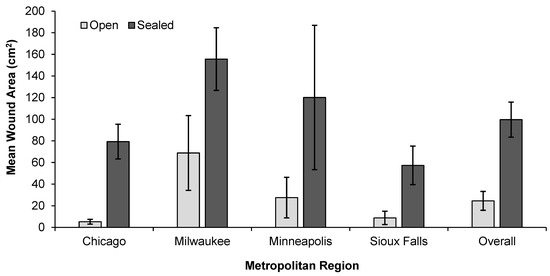
Figure 1.
Mean total wound area by treatment and metropolitan region for open (plug-less) and sealed (plug) systems for emerald ash borer (Agrilus planipennis Fairmaire) treatment in green ash (Fraxinus pennsylvanica Marshall) trees. (Bars are SE, F(1, 363) = 17.406, p < 0.001).
3.2. Association of Trunk Diameter, Region, and Treatment System with Wounds
The logistic model showed that trunk diameter, treatment system, and the region significantly explained the presence of wounds (Table 3). Compared to Chicago, the Milwaukee region had 2.6 times greater odds of wounds. Tree wounds were 7.2 times more likely to be present on the trunk of trees (e.g., within 1.37 m above the ground) treated with a sealed treatment system. A linear regression model showed the number of wounds was similar to the logistic model (Table 4). The number of wounds was found to be explained by trunk diameter, the Milwaukee region, and treatment system. The sealed system had significantly (p < 0.001) more wounds compared with the open system. As trunk diameter increased, significantly (p < 0.001) more wounds were found on a tree.

Table 3.
Logistic model testing the effect if an injected green ash (Fraxinus pennsylvanica Marshall) had a wound (n = 365).

Table 4.
Linear regression model testing the effect on the number of wounds per tree with injected green ash (Fraxinus pennsylvanica Marshall) trees 1.
3.3. Relationship of Treatment System and Proper Application on Wounds
A chi-square analysis revealed a significant difference (p < 0.001, n = 365) in wounding between the open and sealed systems (Table 5). Overall, 28.8% (n = 105) of the sample trees had at least one trunk wound observed, from any cause. The open system had fewer trees showing at least one wound (11.6% of trees) compared with the sealed system (47.4% of trees), with wounds from any cause (e.g., treatment and/or something else). Incorrect treatment application was a significant (p < 0.001, n = 105) explanation for wounds with the sealed system (n = 83) with 77.1% classified as improper treatment application compared with something else (21.7%) or unidentified cause (1.2%). In contrast, the open system (n = 22) wounds were more commonly associated with something else (40.9%) or unidentified cause (36.4%), rather than improper treatment application (22.7%). No significant difference (p = 0.724) was found between the two systems with wounds that were open (e.g., wood observed) or closed, with ~50% of wounds falling into either category.

Table 5.
Percentage of trees with visually observed wounds with open (plug-less) or sealed (plug) systems for tree injection treatment in green ash (Fraxinus pennsylvanica Marshall) trees for emerald ash borer (Agrilus planipennis Fairmaire) 1.
4. Discussion
4.1. Implications of Findings
This study investigated trees growing in situ as part of EAB management programs using two different tree injection systems. Results showed significant differences between these two systems based on visual observations of external wounds. The length of time that the trees had been treated varied from longer-term (e.g., approximately 12 years with 4 to 5 total injections in Milwaukee, WI, USA) to more recently treated trees within a few years (e.g., trees injected once, Sioux Falls, SD, USA). Many factors can explain why wounding was observed in this study and from other observations reported in the peer-reviewed literature. We used the terms open and sealed to distinguish the two systems, which more recently has been used to describe whether a plastic-silicone plug is inserted into the drill hole as a sealed system or if the wound is left open to the ambient environment [10,14].
Treatment method appears to be one factor explaining differences in wounding. In this study the open system had fewer wounds and wound area than the sealed system. Drilling through bark and into wood damages vascular tissue and factors such as the drill bit angle, sharpness, diameter, and drilling speed are all potential factors that if done incorrectly could lead to tissue necrosis [10,14,34]. These factors were not possible to assess in this field study, but a future study could test the effects of drilling. However, we observed that correct application is important, and as such the improper inserting of plugs in the sealed system largely explained higher wounding in this study. We observed plugs were often set too shallow, sometimes even falling out, and not set in the sapwood as the manufactures installation instructions clearly require [10]. Following manufacture recommendations is advised as a best practice for tree injection, and proper plug placement depth is part of this [10].
Bark cracking was observed in this study and was included as a part of overall wounding. Tanis and McCollough [24] observed 5% of green ash and white ash (Fraxinus americana L.) trees developed bark cracking in their field study in central Michigan, MI USA. Aćimović et al. [14] found vertical bark cracking occurred the first season with every system they studied. Smaller (e.g., 4.4 mm drill hole) wounds closed more quickly than larger (e.g., 9.5 mm) wounds [14]. After three years Aćimović et al. [14] found that all small diameter holes completely closed compared with 75% of the larger holes and 8% of large holes sealed with a plastic-silicone plug. In this study tissue necrosis of bark, cambium, and wood was observed. Exposed wood tissue was observed in half of the wounds and was similar for both systems. Initial bark cracking appears to become closed with callus and later wound wood formation [24].
In this study, the positive pressure used by practitioners to push a chemical solution into trees to facilitate uptake was not known. Historic reports of excessive pressure used with tree injection resulting in bark damage and the separation of cambium between the phloem and xylem has been reported with several tree species [35,36,37]. More recently, Smith and Lewis [16] found a high-pressure system at ~2070 to 4140 kPa (300 to 600 psi) led to bark cracking in ash. A 1600 kPa (232 psi) pressure system led to serious bark damage in all seven studied deciduous angiosperms [38]. However, Himelick [39] reported observations with a lag screw injector system with pressures up to ~2760 kpa (400 psi) and no damage reported in American elm (Ulmus americana L.). Following manufacture recommendations in both systems in this study would have rates below ~690 kPa (100 psi).
External injury is an indicator of internal wood discoloration [16]. Dissection of the standing trees in this study was not possible, especially since the selected sample trees were treated to prevent EAB infestation and as such were desired to survive and be part of the street tree population. The few studies that investigated ash species and tree injection found little discoloration within 1 to 2 years [23] and up to 6 years [24] following tree injection. A follow-up investigation of long-term effects of wounding on discoloration is recommended. By example, one question should ask what the long-term effect is with the loss of cambial tissue on ash tree health. Another question is how much time passes for wounds to fully close. A third question could ask does an open wound serve as an infection site for other pathogens. A fourth question involves how much wood discoloration occurs in the sealed system and does this lead to greater wood decay.
4.2. Limitations
This study occurred within four metropolitan regions with a similar climate with one ash tree species. Results from this investigation should be interpreted as associations between various measurements and observed external wounds. It is possible that other tree species and trees grown in other climates may respond differently than those observed in this study. Trees in this study were trunk injected by an unknown number of field practitioners using different approaches and different application methods. This is likely accounted for in the study results through error in the models. The source of the green ash tree and cultivar status, along with the root stock type for cultivars in this study is unknown. Emamectin benzoate of various formulations was used in the treatment programs at all regions. However, it is possible that any one of the formulations may have interacted in the development of wounds. However, no phytotoxic effects of emamectin benzoate formulations have been reported as far as we know in systemic tree injection studies [40,41]. Trees in the sealed system were larger in diameter. However, while the difference is significant, this alone does not account for differences in mean wound number per tree or mean total wound area. A controlled study with tree injections completed by a small subset of practitioners using consistent systems is advised.
5. Conclusions
This study adds to the limited body of short and long-term investigations into tree injection of ash trees to prevent mortality from EAB. A significant difference in mean wound number and mean total wound area was found between open (plug-less) and sealed (plug) systems. The sealed system was associated with a greater number of wounds and greater wound area. Our observations found improper installation of plugs with a sealed system was an important factor associated with wounds. Proper installation of tree injection systems according to manufacture recommendations is vital to decrease external wounding.
Author Contributions
Conceptualization, R.J.H., J.J.B. and E.N.; methodology, R.J.H., J.J.B. and E.N.; validation, R.J.H., J.J.B. and E.N; formal analysis, R.J.H. and E.N; investigation, R.J.H., J.J.B. and E.N.; resources, R.J.H.; data curation, R.J.H.; writing—original draft preparation, R.J.H.; writing—review and editing, R.J.H., J.J.B. and E.N; visualization, R.J.H.; supervision, R.J.H. and J.J.B.; project administration, R.J.H.; funding acquisition, R.J.H. All authors have read and agreed to the published version of the manuscript.
Funding
This research was funded by Rainbow Ecoscience (Minnetonka, MN USA) to support staff time associated with field observations and associated travel expenses during field data collection.
Data Availability Statement
Study data maintained by corresponding author.
Acknowledgments
We thank Morton Arboretum Research Assistants and South Dakota State University Students for assistance with collection of data during the summer 2021 field investigation.
Conflicts of Interest
The authors have no conflicts of interest and the results within the report are based on observations of trees treated with trunk injection systems at the study sites during Summer 2021.
Appendix A
Field observations of tree wounds, bark cracking, and sounding system to detect wound below bark. (All photos by Richard Hauer).
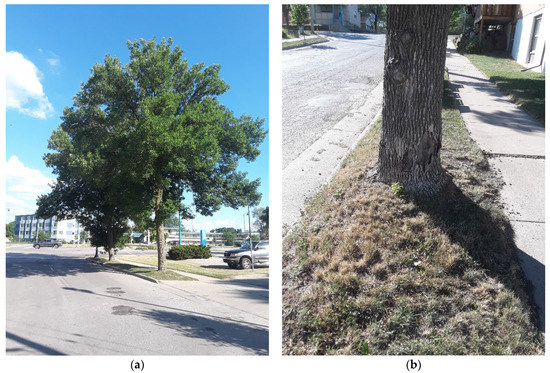
Figure A1.
Example street setting of green ash trees from used in this study from a (a) distance and (b) closeup.
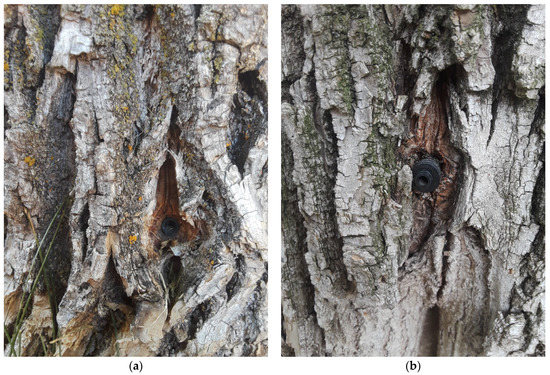
Figure A2.
Plug appearance of improper application (a) set shallow and associated (b) bark cracking.
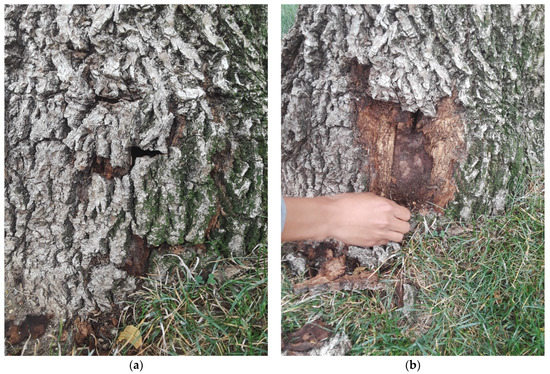
Figure A3.
(a) Appearance of dead bark covering a wound; (b) Appearance of wound after bark was removed.
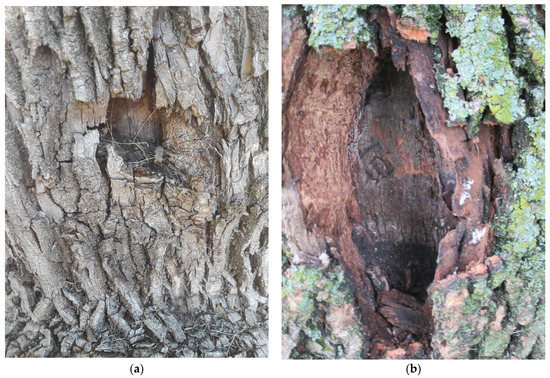
Figure A4.
(a) Example appearance of wound with wound wood development; (b) Example wound with sunken appearance and wound wood development.
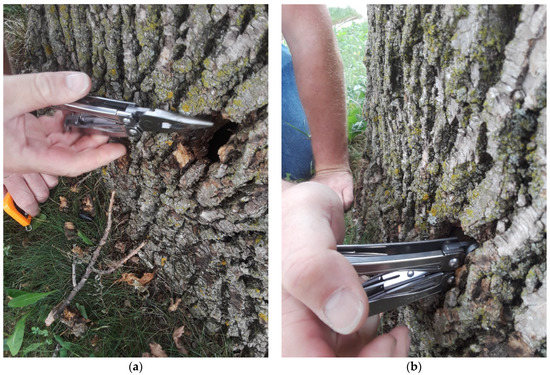
Figure A5.
(a) Example wound partially obscured by bark; (b) Example wound partially obscured by bark with tool inserted.
References
- Cappaert, D.; McCullough, D.G.; Poland, T.M.; Siegert, N.W. Emerald ash borer in North America: A research and regulatory challenge. Am. Entomol. 2005, 51, 152–165. [Google Scholar] [CrossRef]
- Herms, D.A.; McCullough, D.G. Emerald ash borer invasion of North America: History, biology, ecology, impacts, and management. Annu. Rev. Entomol. 2014, 59, 13–30. [Google Scholar] [CrossRef] [PubMed]
- Bick, E.N.; Forbes, N.J.; Haugen, C.; Jones, G.; Bernick, S.; Miller, F. Seven-year evaluation of insecticide tools for emerald ash borer in Fraxinus pennsylvanica (Lamiales: Oleaceae) Trees. J. Econ. Entomol. 2018, 111, 732–740. [Google Scholar] [CrossRef] [PubMed]
- Miller, F.; Mueller, D. Protection of ash trees under extended emerald ash borer pressure. Great Lakes Entomol. 2020, 53, 1–24. [Google Scholar]
- Kovacs, K.F.; Haight, R.G.; McCullough, D.G.; Mercader, R.J.; Siegert, N.W.; Liebhold, A.M. Cost of potential emerald ash borer damage in us communities 2009–2019. Ecol. Econ. 2010, 69, 569–578. [Google Scholar] [CrossRef]
- Hauer, R.J.; Peterson, W. Effects of emerald ash borer on municipal forestry budgets. Landsc. Urban Plan. 2017, 157, 98–105. [Google Scholar] [CrossRef]
- Sadof, C.; Hughes, G.; Witte, A.; Peterson, D.; Ginzel, M. Tools for staging and managing emerald ash borer in the urban forest. Arboric. Urban For. 2017, 43, 15–26. [Google Scholar] [CrossRef]
- Hauer, R.J.; Hanou, I.S.; Sivyer, D. Planning for active management of future invasive pests affecting urban forests: The ecological and economic effects of varying Dutch elm disease management practices for street trees in Milwaukee, WI USA. Urban Ecosyst. 2020, 23, 1005–1022. [Google Scholar] [CrossRef]
- Herms, D.A.; McCullough, D.G.; Clifford, C.S.; Smitley, D.R.; Miller, F.D.; Cranshaw, W. Insecticide Options for Protecting Ash Trees from Emerald Ash Borer. North Central IPM Center Bulletin, 3rd ed. 2019, p. 16. Available online: http://www.emeraldashborer.info/documents/Multistate_EAB_Insecticide_Fact_Sheet.pdf. (accessed on 30 September 2022).
- Bernick, S.; Smiley, T. Best Management Practices—Tree Injection, 2nd ed.; International Society of Arboriculture: Atlanta, GA, USA, 2022; p. 43. [Google Scholar]
- Smitley, D.; Doccola, J.; Cox, D. Multiple-year protection of ash trees from emerald ash borer with a single trunk injection of Emamectin benzoate and single-year protection with an imidacloprid basal drench. Arboric. Urban For. 2010, 36, 206–211. [Google Scholar] [CrossRef]
- Flower, C.E.; Dalton, J.E.; Knight, K.S.; Brikha, M.; Gonzalez-Meler, M.A. To treat or not to treat: Diminishing effectiveness of emamectin benzoate tree injections in ash trees heavily infested by emerald ash borer. Urban For. Urban Green. 2015, 14, 790–795. [Google Scholar] [CrossRef]
- McCullough, D.G.; Poland, T.M.; Tluczek, A.R.; Anulewicz, A.; Wieferich, J.; Siegert, N.W. Emerald ash borer (Coleoptera: Buprestidae) densities over a 6-yr period on untreated trees and trees treated with systemic insecticides at 1-, 2-, and 3-yr intervals in a central Michigan forest. J. Econ. Entomol. 2019, 112, 201–212. [Google Scholar] [CrossRef] [PubMed]
- Aćimović, S.G.; Cregg, B.M.; Sundin, G.W.; Wise, J.C. Wise. Comparison of drill- and needle-based tree injection technologies in healing of trunk injection ports on apple trees. Urban For. Urban Green. 2016, 19, 151–157. [Google Scholar] [CrossRef]
- Brazee, N.; Marra, R.E. Incidence of internal decay in American elms (Ulmus americana) under regular fungicide injection to manage Dutch elm disease. Arboric. Urban For. 2020, 46, 1–11. [Google Scholar] [CrossRef]
- Smith, K.T.; Lewis, P.A. Potential concerns for tree response from stem injection. In Onken Brad; Reardon, Richard, Comps, Proceedings of the Third Hemlock Woolly Adelgid Conference, Asheville, NC, USA, 1–3 February 2005; FHTET-2005-01; U.S. Department of Agriculture, Forest Service, Forest Health Technology Enterprise Team: Washington, DC, USA, 2005; pp. 173–178. [Google Scholar]
- Shigo, A.L. Compartmentalization: A conceptual framework for understanding how trees grow and defend themselves. Annu. Rev. Phytopathol. 1984, 22, 189–214. [Google Scholar] [CrossRef]
- Shigo, A.L. Compartmentalization of decay in trees. Sci. Am. 1985, 252, 96–103. [Google Scholar] [CrossRef]
- Shigo, A.; Money, W.; Dodds, D. Some internal effects of Mauget tree injections. J. Arboric. 1977, 3, 213–220. [Google Scholar] [CrossRef]
- Schwarze, F.W.M.R.; Engels, J.; Mattheck, C. Host-Fungus Interactions: Development and Prognosis of Wood Decay in the Sapwood. In Fungal Strategies of Wood Decay in Trees; Springer: Berlin, Heidelberg, 2000. [Google Scholar] [CrossRef]
- Morris, H.; Hietala, A.M.; Jansen, S.; Ribera, J.; Rosner, S.; A Salmeia, K.; Schwarze, F.W.M.R. Using the CODIT model to explain secondary metabolites of xylem in defence systems of temperate trees against decay fungi. Ann. Bot. 2020, 125, 701–720. [Google Scholar] [CrossRef]
- Smith, K.T. Wounding compartmentalization, and treatment tradeoffs. J. Arboric. 1988, 14, 226–229. [Google Scholar] [CrossRef]
- Doccola, J.J.; Smitley, D.R.; Davis, T.W.; Aiken, J.J.; Wild, P.M. Tree wound response following systemic insecticide trunk injection treatments in green ash (Fraxinus pennsylvanica Marsh.). Arboric. Urban For. 2011, 37, 6–12. [Google Scholar] [CrossRef]
- Tannis, S.R.; McCullough, D.G. Evaluation of xylem discoloration in ash trees associated with macroinjections of a systemic insecticide. Arboric. Urban For. 2016, 42, 389–399. [Google Scholar] [CrossRef]
- Beck, H.E.; Zimmermann, N.E.; McVicar, T.R.; Vergopolan, N.; Berg, A.; Wood, E.F. Present and future Köppen-Geiger climate classification maps at 1-km resolution. Sci. Data 2018, 5, 180214. [Google Scholar] [CrossRef] [PubMed]
- Brokaw, N.; Tompson, J. The H for DBH. For. Ecol. Manag. 2000, 129, 89–91. [Google Scholar] [CrossRef]
- Magarik, Y.A.S.; Roman, L.A.; Henning, J.G. How should we measure the DBH of multi-stemmed urban trees? Urban For. Urban Green. 2020, 47, 126481. [Google Scholar] [CrossRef]
- CTLA. Guide for Plant Appraisal, 9th ed.; Council of Tree and Landscape Appraisers International Society of Arboriculture: Champaign, IL, USA, 2000; p. 143. [Google Scholar]
- Hauer, R.J.; Koeser, A.K.; Parbs, S.; Kringer, J.; Krouse, R.; Ottman, K.; Miller, R.W.; Sivyer, D.; Timilsina, N.; Werner, L.P. Long-term effects of a tree preservation program on tree survival, condition, and growth in Milwaukee, WI, USA. Landsc. Urban Plan. 2020, 193, 103670. [Google Scholar] [CrossRef]
- Smitley, D.; Davis, T.; Rebek, E. Progression of ash canopy thinning and dieback outward from the initial infestation of emerald ash borer (Coleoptera: Buprestidae) in southeastern Michigan. J. Econ. Entomol. 2008, 101, 1643–1650. [Google Scholar] [CrossRef] [PubMed]
- Luley, C.J.; Ellison, M. Do you hear what I hear? Part II: Field application of sounding. Arborist News 2018, 27, 40–44. [Google Scholar]
- IBM Corp. IBM SPSS Statistics for Windows; IBM Corp: Armonk, NY, USA, 2021; Version 28.0. [Google Scholar]
- R Core Team. R: A Language and Environment for Statistical Computing. R Version 4.0.0 (2020-04-24). 2021. Available online: https://www.R-project.org/ (accessed on 30 September 2022).
- Montecchio, L.A. Venturi effect can help cure our trees. J. Vis. Exp. 2013, e51199. [Google Scholar] [CrossRef]
- Roach, W.A. Plant injection as a physiological method. Annu. Bot. 1939, 3, 155–226. [Google Scholar] [CrossRef]
- May, C. Methods of tree injection. Trees Mag. 1941, 4, 7, 10–12, 14, 16. [Google Scholar]
- Perry, T.; Santamour, F.S., Jr.; Stipes, R.J.; Shear, T.; Shigo, A. Exploring alternatives to tree injection. J. Arboric. 1991, 17, 217–226. [Google Scholar] [CrossRef]
- Mayhead, G.J. Observations on the use of a high pressure tree injection system. Arboric. J. 1991, 15, 19–26. [Google Scholar] [CrossRef]
- Himelich, E.B. Pressure injection of chemicals into trees. Arborist’s News 1972, 37, 97–105. [Google Scholar]
- Fettig, C.J.; Munson, A.S.; Grosman, D.M.; Bush, P.B. Evaluations of emamectin benzoate and propiconazole for protecting individual Pinus contorta from mortality attributed to colonization by Dendroctonus ponderosae and associated fungi. Pest Manag. Sci. 2014, 70, 771–778. [Google Scholar] [CrossRef] [PubMed]
- Grosman, D.M.; Fettig, C.J.; Jorgensen, C.L.; Munson, A.S. Effectiveness of two systemic insecticides for protecting western conifers from mortality due to bark beetle attack. West. J. Appl. For. 2010, 25, 181–185. [Google Scholar] [CrossRef]
Publisher’s Note: MDPI stays neutral with regard to jurisdictional claims in published maps and institutional affiliations. |
© 2022 by the authors. Licensee MDPI, Basel, Switzerland. This article is an open access article distributed under the terms and conditions of the Creative Commons Attribution (CC BY) license (https://creativecommons.org/licenses/by/4.0/).